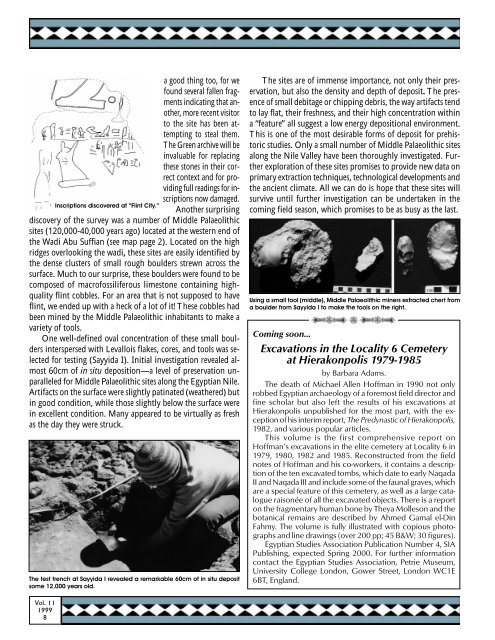Nekhen News 11 - Hierakonpolis Online
Nekhen News 11 - Hierakonpolis Online
Nekhen News 11 - Hierakonpolis Online
You also want an ePaper? Increase the reach of your titles
YUMPU automatically turns print PDFs into web optimized ePapers that Google loves.
a good thing too, for we<br />
found several fallen fragments<br />
indicating that another,<br />
more recent visitor<br />
to the site has been attempting<br />
to steal them.<br />
The Green archive will be<br />
invaluable for replacing<br />
these stones in their correct<br />
context and for providing<br />
full readings for inscriptions<br />
now damaged.<br />
Inscriptions discovered at “Flint City.”<br />
Another surprising<br />
discovery of the survey was a number of Middle Palaeolithic<br />
sites (120,000-40,000 years ago) located at the western end of<br />
the Wadi Abu Suffian (see map page 2). Located on the high<br />
ridges overlooking the wadi, these sites are easily identified by<br />
the dense clusters of small rough boulders strewn across the<br />
surface. Much to our surprise, these boulders were found to be<br />
composed of macrofossiliferous limestone containing highquality<br />
flint cobbles. For an area that is not supposed to have<br />
flint, we ended up with a heck of a lot of it! These cobbles had<br />
been mined by the Middle Palaeolithic inhabitants to make a<br />
variety of tools.<br />
One well-defined oval concentration of these small boulders<br />
interspersed with Levallois flakes, cores, and tools was selected<br />
for testing (Sayyida I). Initial investigation revealed almost<br />
60cm of in situ deposition—a level of preservation unparalleled<br />
for Middle Palaeolithic sites along the Egyptian Nile.<br />
Artifacts on the surface were slightly patinated (weathered) but<br />
in good condition, while those slightly below the surface were<br />
in excellent condition. Many appeared to be virtually as fresh<br />
as the day they were struck.<br />
The test trench at Sayyida I revealed a remarkable 60cm of in situ deposit<br />
some 12,000 years old.<br />
Vol. <strong>11</strong><br />
1999<br />
8<br />
The sites are of immense importance, not only their preservation,<br />
but also the density and depth of deposit. The presence<br />
of small debitage or chipping debris, the way artifacts tend<br />
to lay flat, their freshness, and their high concentration within<br />
a “feature” all suggest a low energy depositional environment.<br />
This is one of the most desirable forms of deposit for prehistoric<br />
studies. Only a small number of Middle Palaeolithic sites<br />
along the Nile Valley have been thoroughly investigated. Further<br />
exploration of these sites promises to provide new data on<br />
primary extraction techniques, technological developments and<br />
the ancient climate. All we can do is hope that these sites will<br />
survive until further investigation can be undertaken in the<br />
coming field season, which promises to be as busy as the last.<br />
Using a small tool (middle), Middle Palaeolithic miners extracted chert from<br />
a boulder from Sayyida I to make the tools on the right.<br />
Coming soon…<br />
Excavations in the Locality 6 Cemetery<br />
at <strong>Hierakonpolis</strong> 1979-1985<br />
by Barbara Adams.<br />
The death of Michael Allen Hoffman in 1990 not only<br />
robbed Egyptian archaeology of a foremost field director and<br />
fine scholar but also left the results of his excavations at<br />
<strong>Hierakonpolis</strong> unpublished for the most part, with the exception<br />
of his interim report, The Predynastic of <strong>Hierakonpolis</strong>,<br />
1982, and various popular articles.<br />
This volume is the first comprehensive report on<br />
Hoffman’s excavations in the elite cemetery at Locality 6 in<br />
1979, 1980, 1982 and 1985. Reconstructed from the field<br />
notes of Hoffman and his co-workers, it contains a description<br />
of the ten excavated tombs, which date to early Naqada<br />
II and Naqada III and include some of the faunal graves, which<br />
are a special feature of this cemetery, as well as a large catalogue<br />
raisonée of all the excavated objects. There is a report<br />
on the fragmentary human bone by Theya Molleson and the<br />
botanical remains are described by Ahmed Gamal el-Din<br />
Fahmy. The volume is fully illustrated with copious photographs<br />
and line drawings (over 200 pp; 45 B&W; 30 figures).<br />
Egyptian Studies Association Publication Number 4, SIA<br />
Publishing, expected Spring 2000. For further information<br />
contact the Egyptian Studies Association, Petrie Museum,<br />
University College London, Gower Street, London WC1E<br />
6BT, England.


